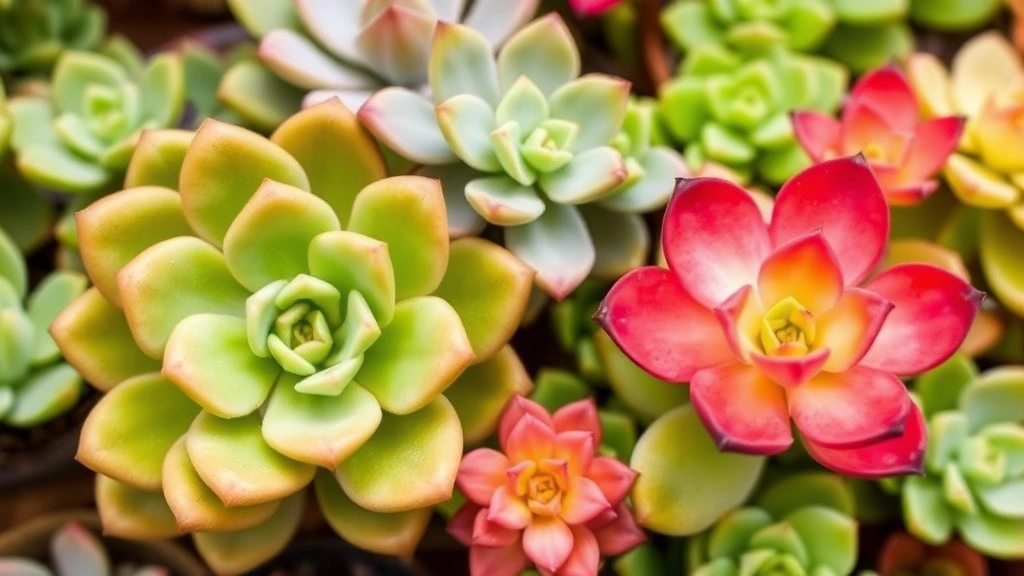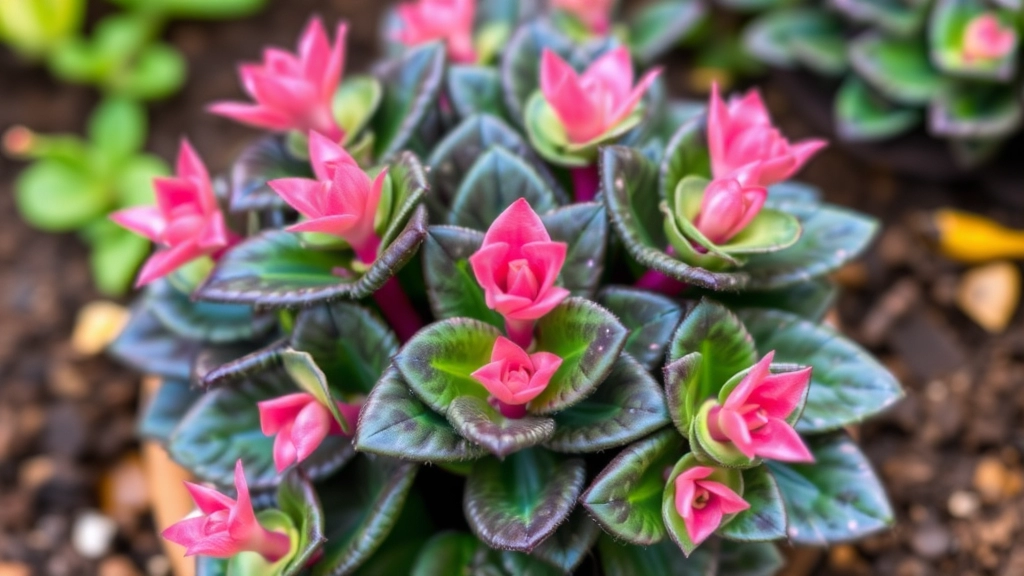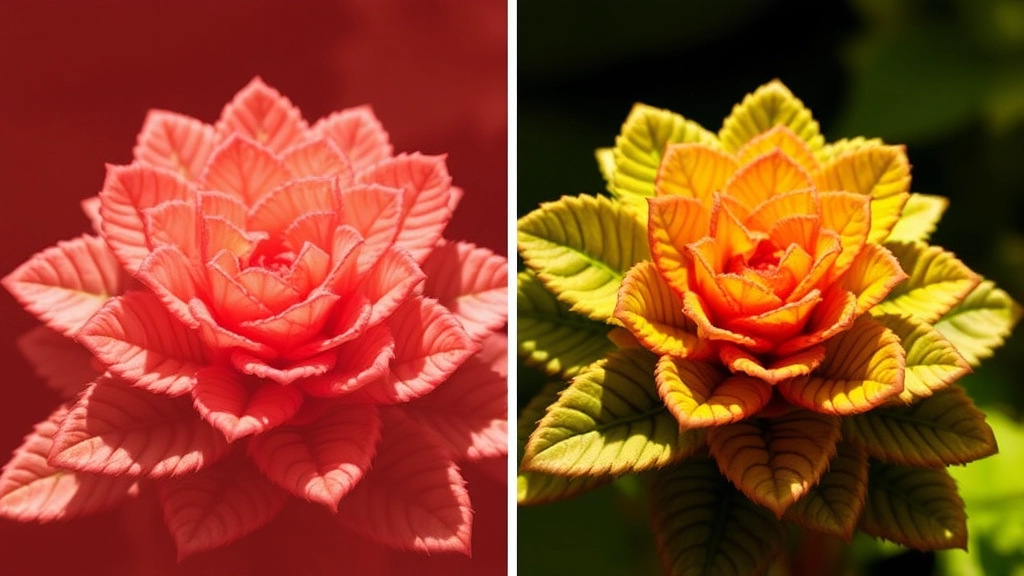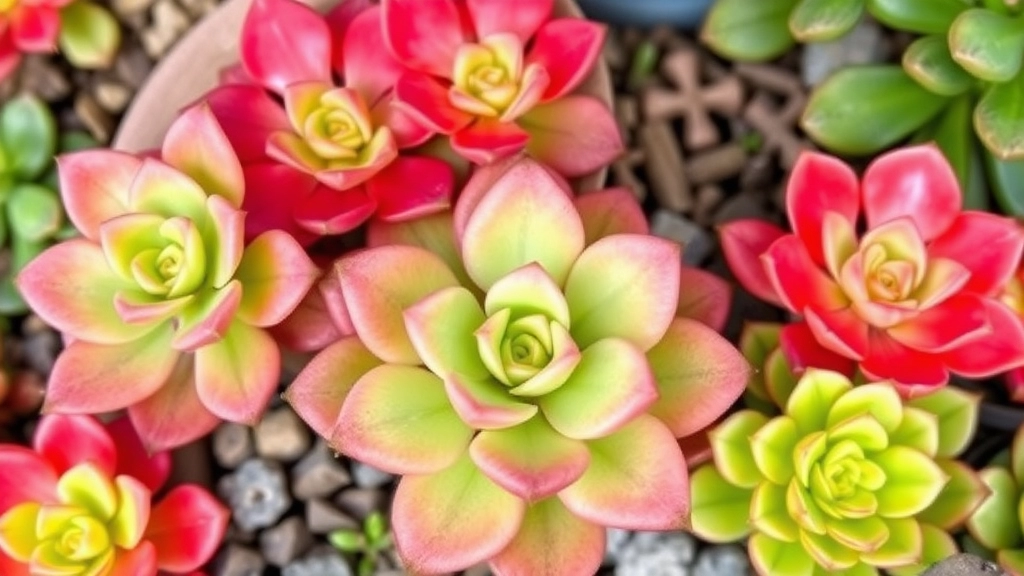Kalanchoe Succulents
Are Kalanchoe succulents? Absolutely! Kalanchoe plants are indeed classified as succulents, known for their thick, fleshy leaves that store water. This unique characteristic makes them a popular choice for those seeking low-maintenance, drought-resistant plants. Whether you’re looking to add a touch of greenery to your home or garden, Kalanchoe succulents are a versatile and attractive option.
Caring for Kalanchoe
Caring for Kalanchoe is straightforward. They thrive in well-draining soil and require minimal watering, making them perfect for busy individuals or novice gardeners. With a variety of stunning species to choose from, these succulents can brighten up any space with their vibrant flowers and lush foliage.
Learn More
Ready to learn more about Kalanchoe succulents and how to care for them? Let’s dive in!
Is Kalanchoe Considered a Succulent?
When it comes to identifying various plant types, many people often wonder, “Is Kalanchoe considered a succulent?”
The answer is a resounding yes!
Kalanchoe is a genus of flowering plants that falls under the succulent category.
Succulents are known for their ability to store water in their leaves, stems, or roots, allowing them to thrive in arid conditions.
Kalanchoe exhibits this characteristic, making it well-suited for dry environments.
Key Characteristics of Kalanchoe as a Succulent:
- Water Storage: Kalanchoe plants have thick, fleshy leaves that retain moisture.
- Drought Resistance: They can survive extended periods without water, adapting well to various climates.
- Variety: There are numerous species within the Kalanchoe genus, each showcasing unique shapes and colours.
For those looking to add a touch of greenery to their space, Kalanchoe offers an array of options that not only beautify but also require minimal care. For more detailed care tips, check out our ultimate guide to caring for Kalanchoe succulents and explore the top Kalanchoe succulent varieties to find the perfect plant for your home.
Common Varieties of Kalanchoe Succulents

So, you’re keen on Kalanchoe, right?
These little beauties come in a range of varieties, each with its own unique charm.
Let’s dive into some of the most popular Kalanchoe succulents you might want to consider for your collection.
1. Kalanchoe Blossfeldiana
- Overview: Known for its vibrant blooms, this variety is often seen in gardens and as houseplants.
- Flowers: Comes in shades of red, pink, orange, and yellow.
- Care Tip: Needs bright light to thrive.
2. Kalanchoe Tomentosa (Panda Plant)
- Overview: This one’s a crowd-pleaser with its fuzzy leaves.
- Leaves: Grey-green with brown edges, resembling panda ears.
- Care Tip: Prefers indirect sunlight and is drought-tolerant.
3. Kalanchoe Daigremontiana (Mother of Thousands)
- Overview: A fascinating variety that produces tiny plantlets along its edges.
- Propagation: Easy to propagate from those little plantlets.
- Care Tip: Thrives in well-drained soil and bright light.
4. Kalanchoe Luciae (Flapjack)
- Overview: Known for its large, flat leaves that can turn a lovely red in the sun.
- Appearance: Looks like a stack of pancakes!
- Care Tip: Enjoys full sun and requires minimal watering.
5. Kalanchoe Fedtschenkoi (Paddle Plant)
- Overview: This variety features stunning, paddle-shaped leaves.
- Leaves: Often have a lovely blue-grey hue.
- Care Tip: Likes bright light and can tolerate some neglect.
Ideal Growing Conditions for Kalanchoe
When growing Kalanchoe succulents, understanding their ideal conditions is crucial for thriving plants.
What do Kalanchoe need to flourish?
- Soil Type: Kalanchoe prefer well-draining soil, ideally a cactus or succulent mix. This helps prevent root rot, a common issue with overly moist conditions. Consider adding perlite or sand for extra drainage.
- Temperature: These plants thrive in warm environments, ideally between 20°C to 25°C (68°F to 77°F). They can tolerate slightly cooler nights but should be protected from frost.
- Humidity Levels: Kalanchoe are not fans of high humidity. They prefer dry air, making them perfect for indoor environments. Keep humidity levels low to mimic their natural habitat.
- Container Choice: If you’re potting your Kalanchoe, choose containers with drainage holes. This allows excess water to escape, further protecting the roots.
- Fertilisation: During the growing season (spring and summer), a diluted succulent fertiliser once a month can boost growth. In autumn and winter, reduce or stop fertilising altogether.
By ensuring these ideal growing conditions, your Kalanchoe will be well on their way to becoming vibrant, healthy plants. For more detailed care instructions, check out our complete guide for healthy growth. If you’re interested in learning about different varieties, visit our top Kalanchoe succulent varieties and care tips.
Watering and Drainage Needs of Kalanchoe

Understanding the watering and drainage needs of Kalanchoe is crucial for their health and growth.
Many plant enthusiasts worry about overwatering or underwatering their succulents.
Kalanchoe, being a succulent, requires a specific watering routine to thrive.
Watering Tips for Kalanchoe
- Frequency: Water your Kalanchoe every 2-3 weeks during the growing season (spring and summer). In the dormant months (fall and winter), reduce watering to once a month.
- Soil Moisture Check: Always check the top inch of the soil. If it feels dry, it’s time to water.
- Watering Method: Water deeply, ensuring that water reaches the roots. This encourages deep root growth.
Drainage Needs
Proper drainage is just as important as watering.
Kalanchoe plants can easily suffer from root rot if left in soggy soil.
- Pot Selection: Use pots with drainage holes. This allows excess water to escape, preventing waterlogged roots.
- Soil Type: A well-draining potting mix is essential. Consider using a cactus or succulent mix, or create your own by mixing regular potting soil with sand or perlite.
Signs of Overwatering
Be vigilant for signs that your Kalanchoe is receiving too much water:
- Yellowing leaves
- Soft, mushy stems
- A foul smell from the soil
If you notice these signs, reduce watering immediately and check the drainage conditions.
How to Propagate Kalanchoe Succulents
If you’ve enjoyed nurturing your Kalanchoe and are now wondering how to expand your collection, propagation is a rewarding and straightforward process.
Why Propagate?
Many plant enthusiasts often ask, “How can I multiply my Kalanchoe without spending a fortune?”
Here’s the good news: Kalanchoe succulents are incredibly easy to propagate, allowing you to create new plants from existing ones.
Methods of Propagation
- Leaf Cuttings
- Select a healthy leaf from your Kalanchoe.
- Allow it to dry for a few hours to form a callus.
- Place the leaf on well-draining soil and mist lightly.
- Roots should develop within a few weeks.
- Stem Cuttings
- Cut a healthy stem with a few leaves.
- Let it dry for a day to form a callus.
- Plant the stem in soil, ensuring it’s upright.
- Water sparingly until roots establish.
- Offsets
- Some Kalanchoe varieties produce offsets (baby plants).
- Gently separate the offset from the mother plant.
- Plant it in its own pot with suitable soil.
Tips for Successful Propagation
- Timing: The best time to propagate is during the growing season (spring to early summer).
- Soil: Use a well-draining cactus mix or a combination of potting soil and sand.
- Humidity: Keep the environment slightly humid to encourage rooting.
By following these simple steps, you can easily expand your Kalanchoe collection or share them with friends. For more detailed guidance, check out our guide on propagating Kalanchoe Beharensis Fang and learn about the care techniques for Kalanchoe Mother of Thousands.
Light and Temperature Preferences of Kalanchoe

Have you ever wondered why your Kalanchoe isn’t thriving the way you’d hoped?
Well, light and temperature play a huge role in keeping these succulents happy.
Light Requirements
Kalanchoe loves bright, indirect sunlight.
Here’s how to make sure it gets just the right amount:
- Location: Place it near a south or west-facing window.
- Duration: Aim for about 6 hours of light daily.
- Signs of Too Much Light: If you see yellowing leaves or scorched spots, it might be getting too much sun.
- Signs of Too Little Light: If your plant is stretching or becoming leggy, it’s craving more light.
Temperature Preferences
Kalanchoe is a bit of a diva when it comes to temperature.
Keep these tips in mind:
- Ideal Range: They thrive between 15°C to 25°C (59°F to 77°F).
- Avoid Cold Drafts: These plants don’t like chilly temperatures. Keep them away from windows that might get too cold at night.
- Heat Sensitivity: While they enjoy warmth, extreme heat can stress them out. Make sure they have some airflow.
Common Issues and Solutions When Caring for Kalanchoe
As we delve deeper into the care of Kalanchoe succulents, it’s essential to address the common issues that can arise. Understanding these challenges will help you maintain a healthy plant.
1. Overwatering
One of the most frequent problems with Kalanchoe is overwatering. This succulent thrives in dry conditions, and too much moisture can lead to root rot.
- Check the soil: Ensure it dries out completely between waterings.
- Use well-draining soil: A cactus mix works wonders.
- Adjust your watering schedule: Water less frequently, especially in winter.
2. Pests
Kalanchoe can attract pests like aphids and mealybugs, which can harm your plant.
- Inspect regularly: Look for signs of pests on leaves and stems.
- Use insecticidal soap: This is effective in treating infestations.
- Isolate affected plants: Prevent the spread of pests to other plants.
3. Leaf Drop
If your Kalanchoe’s leaves are dropping, it could be a sign of stress.
- Assess environmental conditions: Check for sudden temperature changes or drafts.
- Ensure proper light: Too much or too little light can cause stress.
- Maintain humidity levels: Kalanchoe prefers a relatively dry atmosphere.
4. Fading Colour
A Kalanchoe that loses its vibrant colour might not be getting enough light.
- Relocate your plant: Move it to a brighter spot, but avoid direct sunlight.
- Rotate your plant: This ensures even light exposure on all sides.
5. Flowering Issues
If your Kalanchoe isn’t blooming, it may need a little encouragement.
- Provide a rest period: Allow it to rest for a few weeks after flowering.
- Adjust light exposure: Ensure it gets bright, indirect light.
For more detailed care instructions, check out our Kalanchoe plant lifespan care tips and our Mother of Thousands care guide.
FAQs About Kalanchoe Succulents
Are Kalanchoe succulents easy to care for?
Yes, Kalanchoe succulents are relatively easy to care for. They require bright, indirect sunlight, minimal watering, and well-draining soil.
What are some common varieties of Kalanchoe succulents?
Popular varieties include Kalanchoe Blossfeldiana, Kalanchoe Tomentosa (Panda Plant), Kalanchoe Daigremontiana (Mother of Thousands), Kalanchoe Luciae (Flapjack), and Kalanchoe Fedtschenkoi (Paddle Plant).
How often should I water my Kalanchoe succulent?
Water your Kalanchoe every 2-3 weeks during the growing season (spring and summer). Reduce watering to once a month during the dormant months (fall and winter).
What type of soil is best for Kalanchoe succulents?
A well-draining potting mix is essential. You can use a cactus or succulent mix, or create your own by mixing regular potting soil with sand or perlite.
What are the signs of overwatering my Kalanchoe?
Signs of overwatering include yellowing leaves, soft and mushy stems, and a foul smell from the soil. If you notice these signs, reduce watering immediately and check the drainage conditions.
Where should I place my Kalanchoe for optimal light?
Place your Kalanchoe near a south or west-facing window to ensure it gets about 6 hours of bright, indirect sunlight daily.
What temperature range is ideal for Kalanchoe succulents?
Kalanchoe thrives in temperatures between 15°C to 25°C (59°F to 77°F). Keep them away from cold drafts and extreme heat.
Can Kalanchoe succulents tolerate neglect?
Yes, some varieties like Kalanchoe Tomentosa (Panda Plant) and Kalanchoe Fedtschenkoi (Paddle Plant) can tolerate some neglect, making them ideal for busy plant owners.
How can I propagate my Kalanchoe succulent?
Kalanchoe Daigremontiana (Mother of Thousands) is particularly easy to propagate. It produces tiny plantlets along its edges that can be planted to grow new succulents.
What are the signs that my Kalanchoe is getting too much light?
If you see yellowing leaves or scorched spots, your Kalanchoe might be getting too much sun. Adjust its location to ensure it receives bright, indirect light.
What should I do if my Kalanchoe is stretching or becoming leggy?
If your plant is stretching or becoming leggy, it’s likely craving more light. Move it to a brighter location to ensure it gets adequate sunlight.
References
-
Growing Kalanchoe Succulents
-
Kalanchoe Succulent Care
-
Kalanchoe Plant Guide
